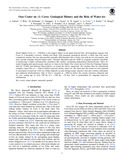| dc.contributor.author | Nathues, A. | |
| dc.contributor.author | Platz, T. | |
| dc.contributor.author | Hoffmann, M. | |
| dc.contributor.author | Thangjam, G. | |
| dc.contributor.author | Cloutis, E. A. | |
| dc.contributor.author | Applin, D. M. | |
| dc.contributor.author | Le Corre, L. | |
| dc.contributor.author | Reddy, V. | |
| dc.contributor.author | Mengel, K. | |
| dc.contributor.author | Protopapa, S. | |
| dc.contributor.author | Takir, D. | |
| dc.contributor.author | Preusker, F. | |
| dc.contributor.author | Schmidt, B. E. | |
| dc.contributor.author | Russell, C. T. | |
| dc.date.accessioned | 2018-03-02T16:54:04Z | |
| dc.date.available | 2018-03-02T16:54:04Z | |
| dc.date.issued | 2017-08-04 | |
| dc.identifier.citation | Nathues, A., T. Platz, M. Hoffmann, G. Thangjam, E.A. Cloutis, D.M. Applin, L. Le Corre, V. Reddy, K. Mengel, S. Protopapa, D. Takir, F. Preusker, B.E. Schmidt, and C.T. Russell. "Oxo crater on (1) Ceres: Geological history and the role of water-ice." Astronomical Journal 154 (3) (2017): 84 (13 pp). DOI: 10.3847/1538-3881/aa7a04. | en_US |
| dc.identifier.issn | 0004-6256 | |
| dc.identifier.uri | http://hdl.handle.net/10680/1374 | |
| dc.description.abstract | Dwarf planet Ceres (∅ ∼ 940 km) is the largest object in the main asteroid belt. Investigations suggest that Ceres is a thermally evolved, volatile-rich body with potential geological activity, a body that was never completely molten, but one that possibly partially differentiated into a rocky core and an ice-rich mantle, and may contain remnant internal liquid water. Thermal alteration and the infall of exogenic material contribute to producing a (dark) carbonaceous chondritic-like surface containing ammoniated phyllosilicates. Here we report imaging and spectroscopic analyses of data on the bright Oxo crater derived from the Framing Camera and the Visible and Infrared Spectrometer on board the Dawn spacecraft. We confirm that the transitional complex crater Oxo (∅ ∼ 9 km) exhibits exposed surface water-ice. We show that this water-ice-rich material is associated exclusively with two lobate deposits at pole-facing scarps, deposits that also contain carbonates and admixed phyllosilicates. Due to Oxo’s location at −4802 m below the cerean reference ellipsoid and its very young age of only 190 ka (1σ: +100 ka, −70 ka), Oxo is predestined for ongoing water-ice sublimation. | en_US |
| dc.description.sponsorship | The Framing Camera project is financially supported by the Max Planck Society and the
German Space Agency, DLR. | |
| dc.description.uri | http://iopscience.iop.org/article/10.3847/1538-3881/aa7a04/meta | |
| dc.language.iso | en | en_US |
| dc.publisher | The Astronomical Journal | en_US |
| dc.rights | info:eu-repo/semantics/openAccess | |
| dc.subject | minor planets | en_US |
| dc.subject | asteroids: general | |
| dc.title | Oxo Crater on (1) Ceres: Geological History and the Role of Water-ice | en_US |
| dc.type | Article | en_US |
| dc.identifier.doi | 10.3847/1538-3881/aa7a04 | |

